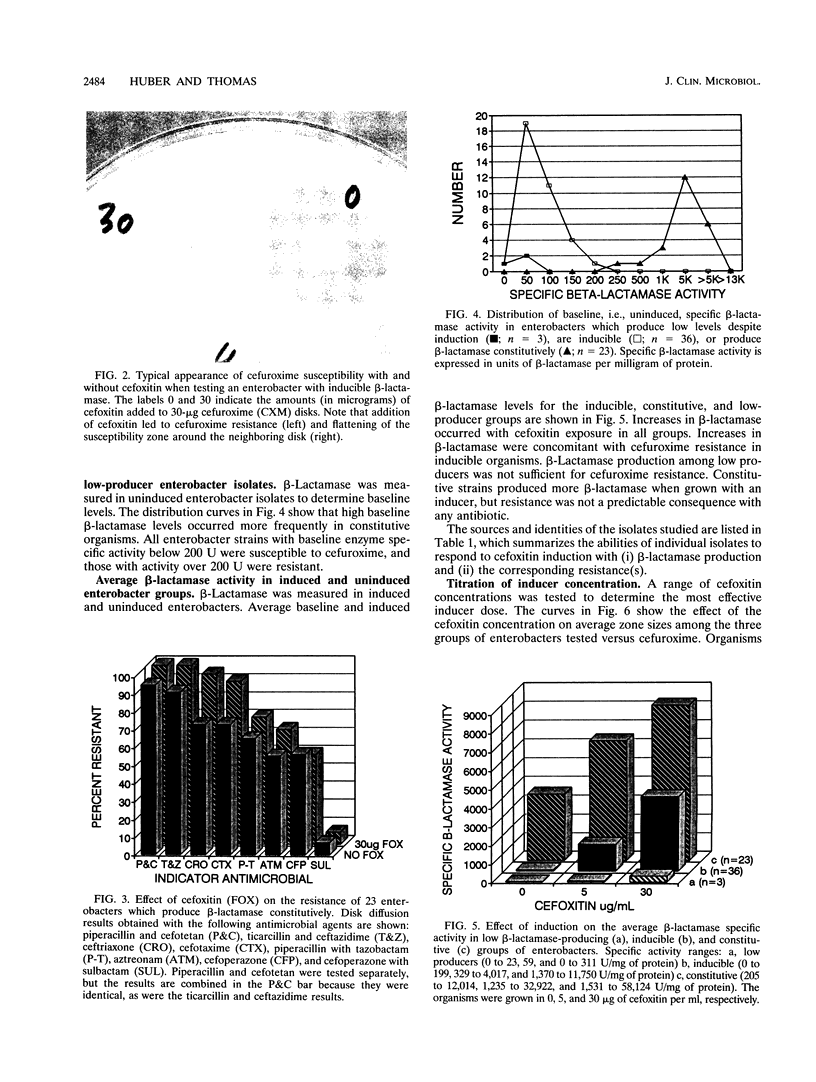Abstract
Thirty-six of 36 strains of Enterobacter cloacae and E. aerogenes with inducible beta-lactamase developed resistance when cefoxitin (inducer) was added to cefuroxime disks. Constitutive beta-lactamase producers (n = 23) were all resistant to cefuroxime. Cefuroxime resistance correlated with the amount of induced or constitutive beta-lactamase. Cefuroxime was a better indicator of induced resistance than cefamandole, cefazolin, cephalothin, ceftriaxone, cefotaxime, ticarcillin with or without clavulanic acid, or cefotetan. Induction by addition of cefoxitin to disks occasionally reduced zone sizes but not enough to change interpretations for ceftazidime, ceftizoxime, aztreonam, cefoperazone with or without sulbactam, and piperacillin with or without tazobactam. Most enterobacters were resistant to cefmetazole. The cefoxitin inducer-cefuroxime indicator method can be used in routine clinical laboratories to detect latent resistance due to chromosomally mediated inducible beta-lactamase in enterobacters.
Full text
PDF





Images in this article
Selected References
These references are in PubMed. This may not be the complete list of references from this article.
- Barry A. L., Jones R. N. Criteria for disk susceptibility tests and quality control guidelines for the cefoperazone-sulbactam combination. J Clin Microbiol. 1988 Jan;26(1):13–17. doi: 10.1128/jcm.26.1.13-17.1988. [DOI] [PMC free article] [PubMed] [Google Scholar]
- Beckwith D. G., Jahre J. A. Role of a cefoxitin-inducible beta-lactamase in a case of breakthrough bacteremia. J Clin Microbiol. 1980 Oct;12(4):517–520. doi: 10.1128/jcm.12.4.517-520.1980. [DOI] [PMC free article] [PubMed] [Google Scholar]
- Cullmann W., Dalhoff A., Dick W. Nonspecific induction of beta-lactamase in Enterobacter cloacae. J Gen Microbiol. 1984 Jul;130(7):1781–1786. doi: 10.1099/00221287-130-7-1781. [DOI] [PubMed] [Google Scholar]
- Cullmann W. Interaction of beta-lactamase inhibitors with various beta-lactamases. Chemotherapy. 1990;36(3):200–208. doi: 10.1159/000238767. [DOI] [PubMed] [Google Scholar]
- Ehrhardt A. F., Sanders C. C. beta-Lactam resistance amongst Enterobacter species. J Antimicrob Chemother. 1993 Nov;32 (Suppl B):1–11. doi: 10.1093/jac/32.suppl_b.1. [DOI] [PubMed] [Google Scholar]
- Gatus B. J., Bell S. M., Jimenez A. S. Comparison of glycine enhancement with cefoxitin induction of class 1 beta-lactamase production in Enterobacter cloacae ATCC 13047. J Antimicrob Chemother. 1988 Feb;21(2):163–170. doi: 10.1093/jac/21.2.163. [DOI] [PubMed] [Google Scholar]
- Jones R. N., Wilson H. W., Novick W. J., Jr, Barry A. L., Thornsberry C. In vitro evaluation of CENTA, a new beta-lactamase-susceptible chromogenic cephalosporin reagent. J Clin Microbiol. 1982 May;15(5):954–958. doi: 10.1128/jcm.15.5.954-958.1982. [DOI] [PMC free article] [PubMed] [Google Scholar]
- Lindh E., Dornbusch K., Jalakas K., Forsgren A. Antibiotic susceptibility and beta-lactamase production in clinical isolates of Enterobacter spp. APMIS. 1990 May;98(5):462–470. [PubMed] [Google Scholar]
- Livermore D. M., Akova M., Wu P. J., Yang Y. J. Clavulanate and beta-lactamase induction. J Antimicrob Chemother. 1989 Nov;24 (Suppl B):23–33. doi: 10.1093/jac/24.suppl_b.23. [DOI] [PubMed] [Google Scholar]
- Okonogi K., Sugiura A., Kuno M., Higashide E., Kondo M., Imada A. Effect of beta-lactamase induction on susceptibility to cephalosporins in Enterobacter cloacae and Serratia marcescens. J Antimicrob Chemother. 1985 Jul;16(1):31–42. doi: 10.1093/jac/16.1.31. [DOI] [PubMed] [Google Scholar]
- Preheim L. C., Penn R. G., Sanders C. C., Goering R. V., Giger D. K. Emergence of resistance to beta-lactam and aminoglycoside antibiotics during moxalactam therapy of Pseudomonas aeruginosa infections. Antimicrob Agents Chemother. 1982 Dec;22(6):1037–1041. doi: 10.1128/aac.22.6.1037. [DOI] [PMC free article] [PubMed] [Google Scholar]
- Sanders C. C., Sanders W. E., Jr Emergence of resistance during therapy with the newer beta-lactam antibiotics: role of inducible beta-lactamases and implications for the future. Rev Infect Dis. 1983 Jul-Aug;5(4):639–648. doi: 10.1093/clinids/5.4.639. [DOI] [PubMed] [Google Scholar]
- Sanders C. C., Sanders W. E., Jr Emergence of resistance to cefamandole: possible role of cefoxitin-inducible beta-lactamases. Antimicrob Agents Chemother. 1979 Jun;15(6):792–797. doi: 10.1128/aac.15.6.792. [DOI] [PMC free article] [PubMed] [Google Scholar]
- Sanders C. C., Sanders W. E., Jr Microbial resistance to newer generation beta-lactam antibiotics: clinical and laboratory implications. J Infect Dis. 1985 Mar;151(3):399–406. doi: 10.1093/infdis/151.3.399. [DOI] [PubMed] [Google Scholar]
- Seeberg A. H., Tolxdorff-Neutzling R. M., Wiedemann B. Chromosomal beta-lactamases of Enterobacter cloacae are responsible for resistance to third-generation cephalosporins. Antimicrob Agents Chemother. 1983 Jun;23(6):918–925. doi: 10.1128/aac.23.6.918. [DOI] [PMC free article] [PubMed] [Google Scholar]
- Thore M., Jalakas K., Eriksson I., Dornbusch K. Evaluation of a disk approximation test of inducible beta-lactamases in Enterobacteriacae and Pseudomonas aeruginosa. APMIS. 1989 Apr;97(4):317–324. [PubMed] [Google Scholar]



